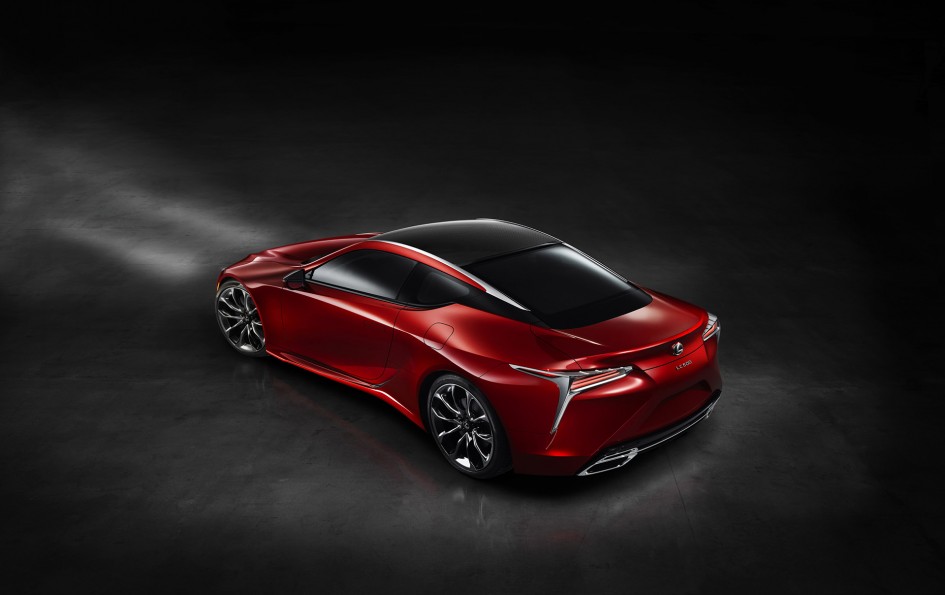Partager la publication "Lexus LC 500 : レクサス Luxury Coupe, V8 5.0L 473 ch. exporté à Detroit présenté au NAIAS 2016"
Souvenez vous … en 2012, ou ne vous souvenez pas… je vous l’affirme, en 2012, Lexus avait sensation avec un concept hors norme… le concept-car LF-LC… appartenant aux modèles de la ligne ‘Lexus Futur’, préfigurant la future identité stylistique de la marque. A Detroit, 2016, comme en …janvier 1989 à ses début au North American International Auto Show … Lexus fait sensation cette année avec le concept LF-LC proposé de série dénommé Lexus LC 500.
Toyota & Lexus
En 1983, le président de Toyota Eiji Toyoda organise une réunion secrète avec les dirigeants de la firme, auxquels il pose une simple question : « Pouvons-nous créer un véhicule de luxe capable de présenter une alternative aux meilleurs mondiaux ? »
Cette question amena Toyota à s’embarquer dans un projet top-secret répondant au nom de code F1 : F pour flagship (porte-drapeaux) et 1 pour le premier véhicule. L’objectif était de développer une voiture de luxe pour étendre l’offre de Toyota en faisant un premier pas dans le segment premium, offrant aussi bien à la clientèle fidèle qu’à de nouveaux acheteurs, un produit haut de gamme.
Les chercheurs de Toyota visitèrent les États-Unis en mai 1985 pour conduire des enquêtes de marché auprès des acheteurs de voitures haut de gamme. Cet été-là, de nombreux designers du projet F1 louèrent une maison à Laguna Beach afin d’observer le style de vie et les goûts des Américains aisés. Les enquêtes de Toyota montrèrent qu’une marque et un réseau de vente séparés étaient nécessaires pour présenter ce nouveau porte-drapeau du luxe automobile japonais.
En 1986, Honda lance la marque Acura aux États-Unis, influençant les plans de Toyota pour une division de luxe. Vers la même époque, Nissan dévoilait son intention de créer sa propre division de luxe, Infiniti, tandis que Mazda pensait aussi à sa nouvelle marque de luxe, Amati, qui ne vit jamais le jour.
Lexus – レクサス Rekusasu – luxury exports to the U.S.
En 1986, l’agence de publicité traditionnelle de Toyota, Saatchi & Saatchi, forme une unité spéciale, Team One, pour prendre en main le marketing de la nouvelle marque de luxe. L’agence de conseil Lippincott & Margulies est engagée pour développer une liste de 219 noms éventuels ; Vectre, Verone, Chaparel, Calibre, et Alexis sont ceux retenus finalement. Tandis qu’Alexis devenait rapidement le favori, il fut finalement modifié en ‘Lexus’ (レクサス Rekusasu), nom qui associait à la fois l’idée de luxe et d’élégance. Une autre théorie veut que celui-ci soit un acronyme de ‘luxury exports to the U.S.’ (exports de luxe aux États-Unis). Au regard des interviews du Team One, le nom n’a pas de signification particulière et donne simplement une image de luxe et de technologie.
Le logo choisi pour Lexus est un “L” stylisé dans un ovale, qui, aux dires de Toyota, fut choisi en suivant une formule mathématique précise. Les nom et logo Lexus tels que choisis par le Team One apparurent finalement aux salons automobiles de Chicago, Los Angeles, et New York en 1988.
Lexus 1989 NAIAS
En 1989, après un long processus de développement impliquant 60 designers, 24 équipes de développement, 1400 ingénieurs, 2300 techniciens, 220 ouvriers, environ 450 prototypes, et plus d’un milliard de dollars de coûts, le projet F1 était achevé. L’automobile créée, la Lexus LS 400, avait un design unique qui ne partageait pas beaucoup d’éléments avec les Toyota précédentes et un nouveau V8 de 4 litres.
La LS 400 fit ses débuts en janvier 1989 au salon automobile de Detroit. En septembre de la même année, les modèles Lexus étaient proposés dans un réseau de 81 concessions à travers les États-Unis. La LS 400 était vendue en parallèle de la moins prestigieuse ES 250, basée sur une Toyota Camry. Le lancement de Lexus fut accompagné d’une campagne publicitaire dans la presse et à la télévision, de plusieurs millions de dollars.
Les débuts de Lexus furent un choc pour les marques européennes : les marques BMW et Mercedes-Benz enregistrant une chute des ventes de respectivement 29 % et 19 % aux États-Unis.
En 1991, Lexus lance son premier coupé sportif, la SC 400, qui partageait le V8 de la LS 400. Ceci précéda le remplacement de l’ES 250 par l’ES 300. À la fin de l’année 1991, Lexus était devenu le constructeur de luxe étranger vendant le plus de voitures aux États-Unis.
En 2005, Lexus voit ses relations avec la compagnie mère Toyota modifiées par l’apparition de centres de design, de recherche, d’essais et de fabrication dédiés exclusivement à la marque. Cet effort coïncide avec le lancement de Lexus dans son pays natal, le Japon, ainsi que dans beaucoup d’autres marchés à travers le monde. Les dirigeants visent alors à augmenter les ventes de la marque en dehors de son plus grand marché que représentait les États-Unis.
Les nouvelles générations des berlines IS, GS et LS sont donc dessinées avec en tête la nécessité d’en faire des modèles pour le marché international, et donc susceptibles de plaire à toutes les marchés.
Lexus introduced a new design language known as « L-finesse » in the mid-2000s with its LF series concepts and the 2006 Lexus GS. L-finesse is represented by three Japanese kanji characters which translate as « Intriguing Elegance, Incisive Simplicity, and Seamless Anticipation ». Design characteristics, including a fastback profile, lower-set grille,[188] and the use of both convex and concave surfaces, are derived from Japanese cultural motifs (e.g. the phrase kirikaeshi in arrowhead shapes).
While earlier Lexus models were criticized for reserved and derivative styling, and often mistaken for understated domestic market cars, automotive design analyses described L-finesse as adding a distinctive nature and embrace of Japanese design identity.
Lexus 2012 NAIAS
Lexus LF-LC
Designated LF-LC for Lexus Future-Luxury Coupe, the concept two-door vehicle premiered in January 2012 at the North American International Auto Show. The vehicle’s exterior and interior styling was created by the Calty Design Research center in Newport Beach, California.
En complément voir : Toyota FT-1 Concept: The Ultime of Future Toyota by Calty Design Research
Lexus LF-LC Concept Vehicle – Official Unveiling
Lexus officially unveils the LF-LC concept hybrid 2+2 coupe at the North American International Auto Show. Be a part of one of the most anticipated reveals as Lexus debuts the new LF-LC in Detroit.
Lexus LF-LC Concept Car – Behind the Scenes Design Process With CALTY
Calty Design Research Incorporated (also simply known as Calty) is a Toyota design studio established in 1973. They have two facilities: one in Newport Beach, California, and another in Ann Arbor, Michigan. Calty’s primary focus is exterior styling. Calty provides advanced design, production color and wheel design concepts for Toyota’s product development operations. Designing the Lexus hybrid concept coupe was exciting for the Calty designers. Get their behind-the-scenes take on this stunning new concept.
Lexus 2016 NAIAS
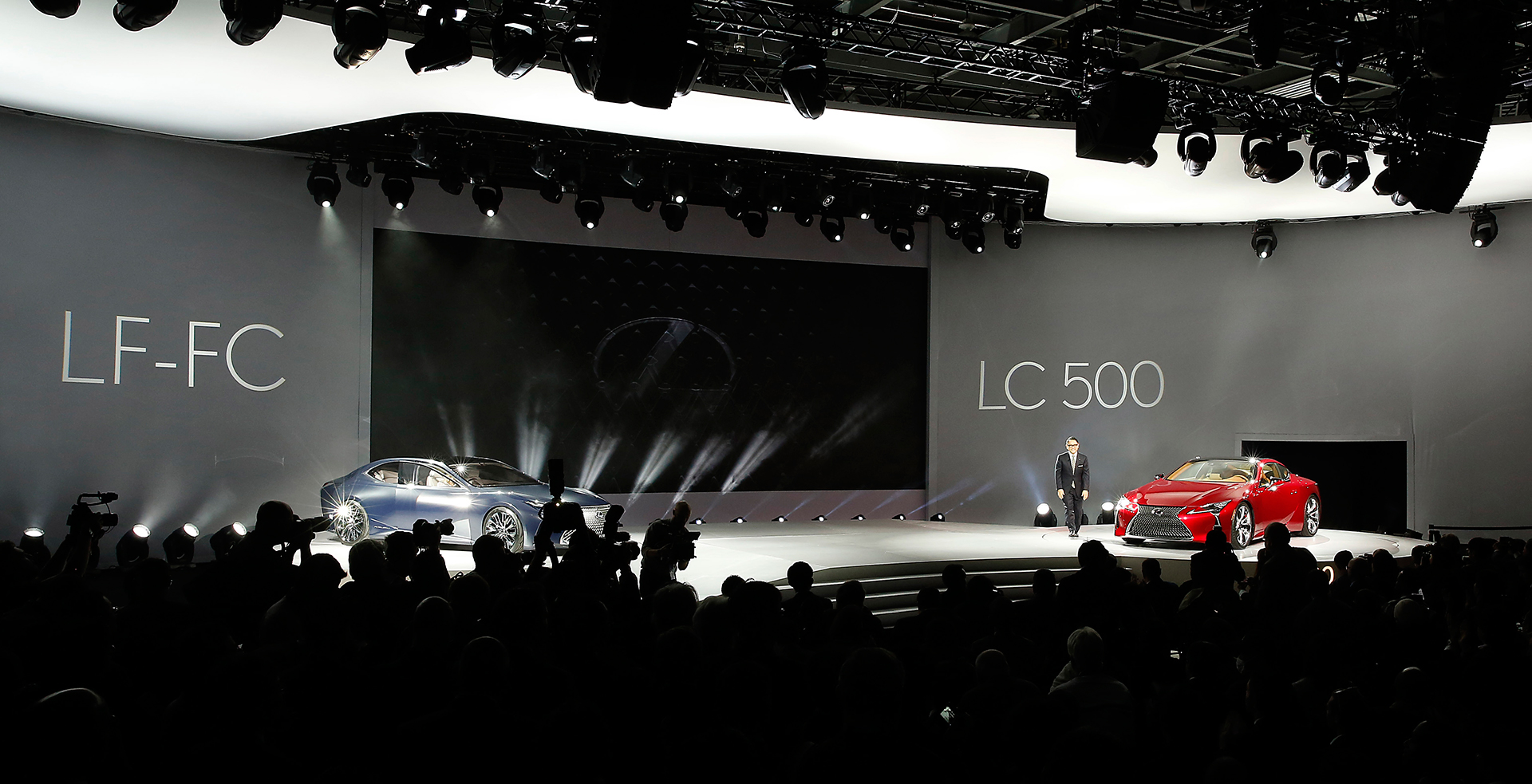
Lexus LF-LC – Lexus LC 500 – Press Conference – NAIAS 2016
Watch as Lexus unveils the all-new LC 500 live from the North American International Auto Show (NAIAS) in Detroit on January 11. Originally created as the visionary LF-LC concept hybrid 2+2 coupe, the LC 500 is now a powerful reality.
Lexus LC 500 révélé au NAIAS 2016
Lexus LC 500: World Premiere
The rest of the world said it was impossible to engineer. This is what impossible looks like. Introducing the all-new LC 500. Unveiled at the North American International Auto Show (NAIAS) in Detroit on January 11. From visionary concept car to powerful reality.
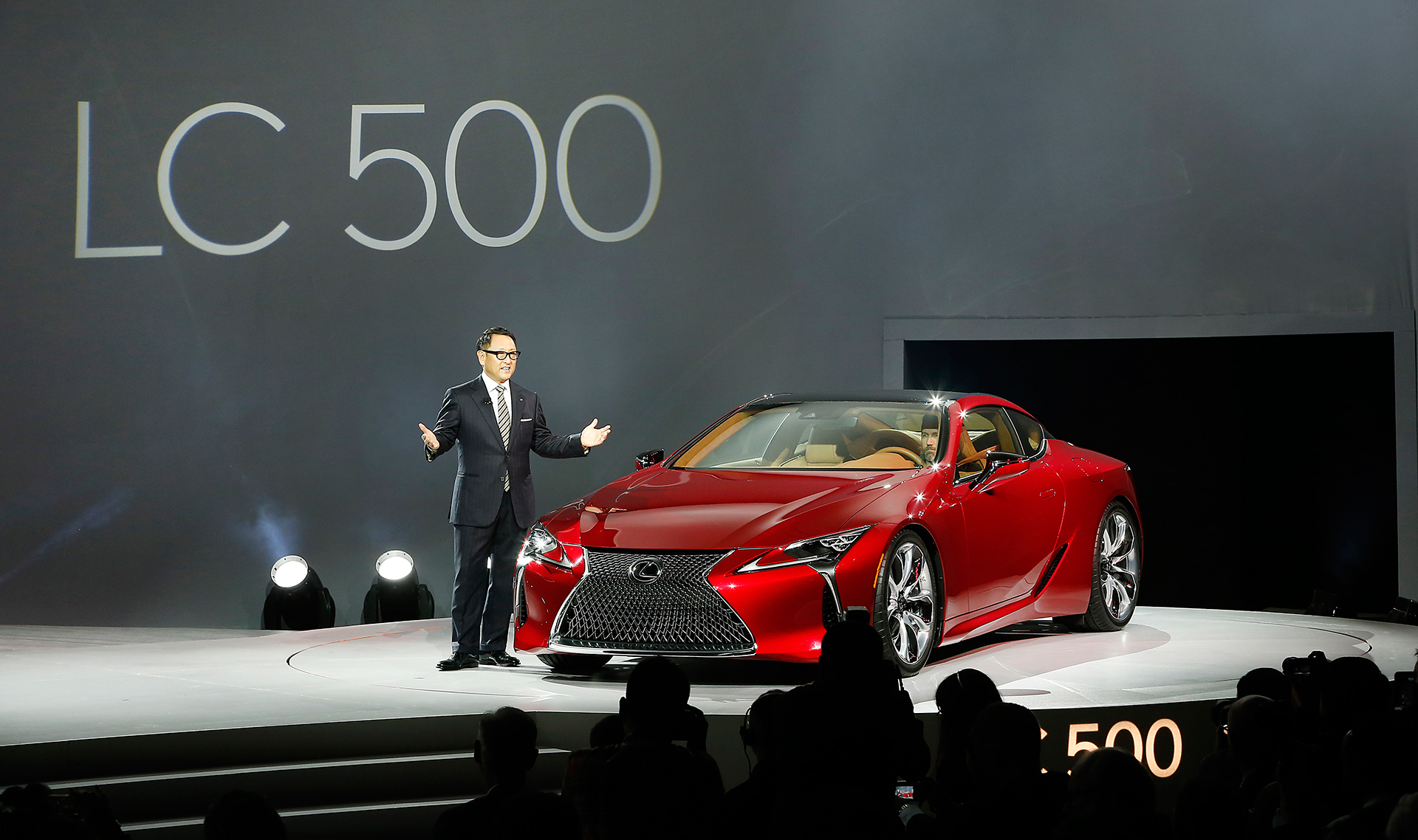
Lexus LC 500 – Press Conference – NAIAS 2016
Le design de la Lexus LC 500
Après la révélation du concept Lexus LF-LC au Salon de Détroit 2012, la presse, les fidèles de la marque Lexus et les passionnés d’automobile se sont demandés si le style époustouflant et les proportions spectaculaires du concept-car pourraient un jour évoluer vers un coupé 2+2 … de série !
Aujourd’hui, quatre ans après les débuts de ce concept, Lexus présente le modèle de série qui s’en inspire. Voilà le tout nouveau coupé de luxe LC 500. Ce coupé emblématique, provocateur et athlétique, constitue la plus forte incarnation à ce jour de la future orientation de la marque pour Lexus.
« Le LC 500 est un produit important pour Lexus mais aussi pour moi-même. Il y a quelques années, nous avons décidé d’orienter l’avenir de la marque avec des produits incarnant davantage la passion et la distinction sur le marché premium. Par ses proportions, son design surprenant et ses performances, cet emblématique coupé de luxe affiche avec force l’orientation émotionnelle de notre marque et accroîtra la séduction du luxe Lexus au niveau mondial. » - Akio Toyoda, Chief Branding Officer et Master Driver de Lexus
Au-delà de son brio stylistique et de ses performances impressionnantes, le nouveau LC 500 est le symbole de ce qui devient possible grâce à la collaboration accrue entre les équipes du design et de l’ingénierie et leur volonté de surmonter leurs obstacles respectifs.
Le développement du LC 500 a été guidé par un objectif de design fondamental, fort et séduisant, celui annoncé par le concept LF-LC. Les équipes de l’ingénierie ont travaillé sans relâche sur de nouvelles solutions permettant de conserver le plus possible les éléments du concept-car pour le modèle de série.
Pour Lexus, le projet LC 500 a largement dépassé le simple cadre du développement d’un nouveau coupé. Le LC 500, sous-tendu par un changement de paradigme dans les procédés d’ingénierie et le travail du design, symbolise le début d’une nouvelle phase pour la marque Lexus.
« Les designers et les ingénieurs ont travaillé ensemble pour surmonter un à un les problèmes et les obstacles. J’ai le sentiment que le résultat va bien au-delà de la simple fidélité à l’esprit stylistique du concept-car. » - Koji Sato, ingénieur en chef
La grande réussite de la collaboration entre les équipes de l’ingénierie est immédiatement évidente tant la philosophie stylistique du LF-LC a été préservée pour le LC 500.
Le design extérieur de la Lexus LC 500
Le modèle de série partage un grand nombre des principaux éléments stylistiques, des proportions et des lignes dynamiques du concept-car dont il s’inspire. Le LC 500 séduit par ses formes athlétiques et aérodynamiques, des courbes et des surfaces sensuelles et la fluidité de la ligne du toit proposé, en fibre de carbone, ou en verre, qui dessinent une silhouette abaissée, large et imposante abritant une architecture très fonctionnelle et dédiée à la passion automobile.
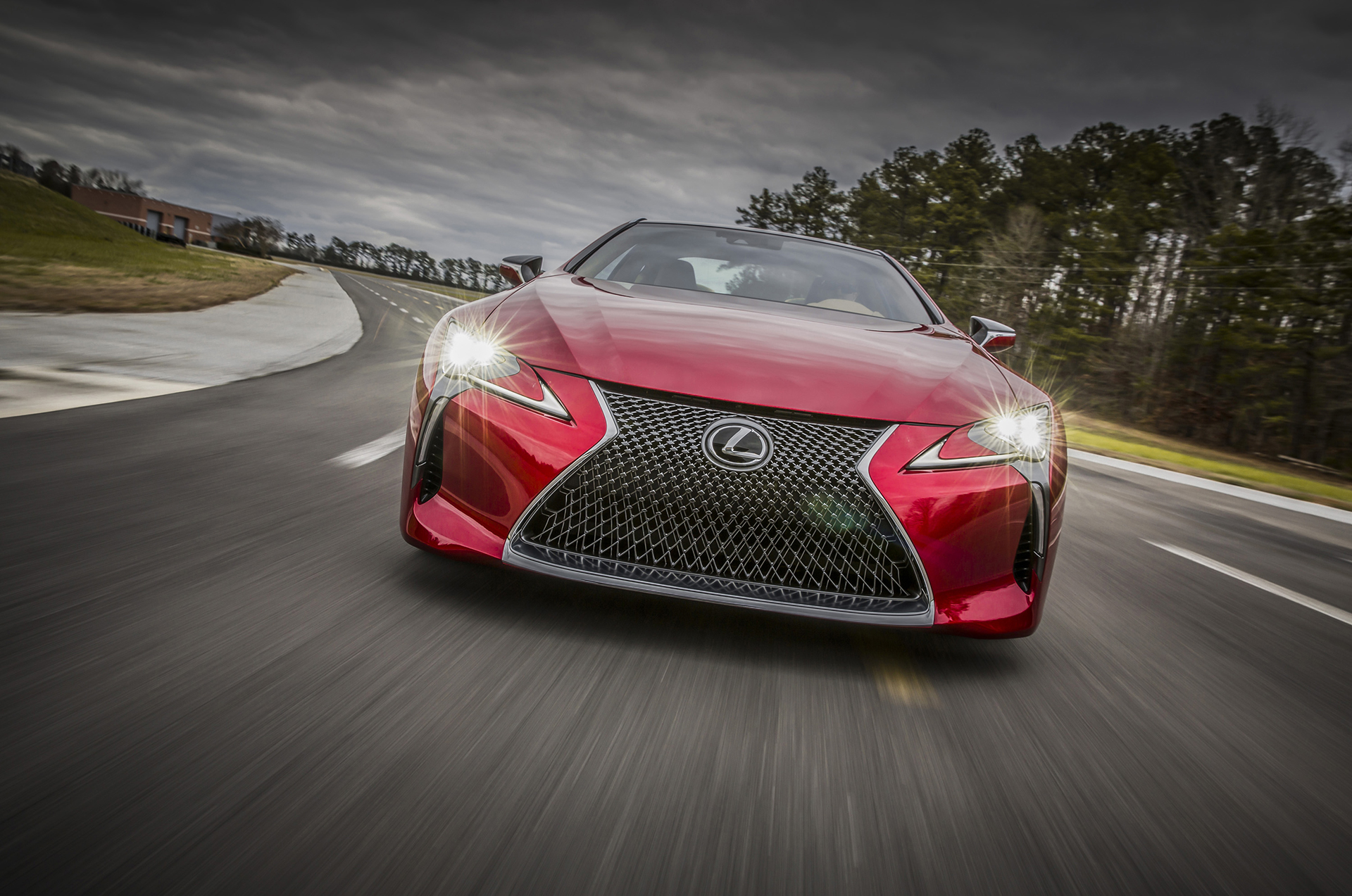
Lexus LC 500 – 2016 – front / avant
La face avant du LC 500 arbore une interprétation puissante de la calandre identitaire trapézoïdale Lexus et de nouveaux blocs optiques à triple LED spécialement conçus pour abriter l’un des projecteurs les plus fins du marché.
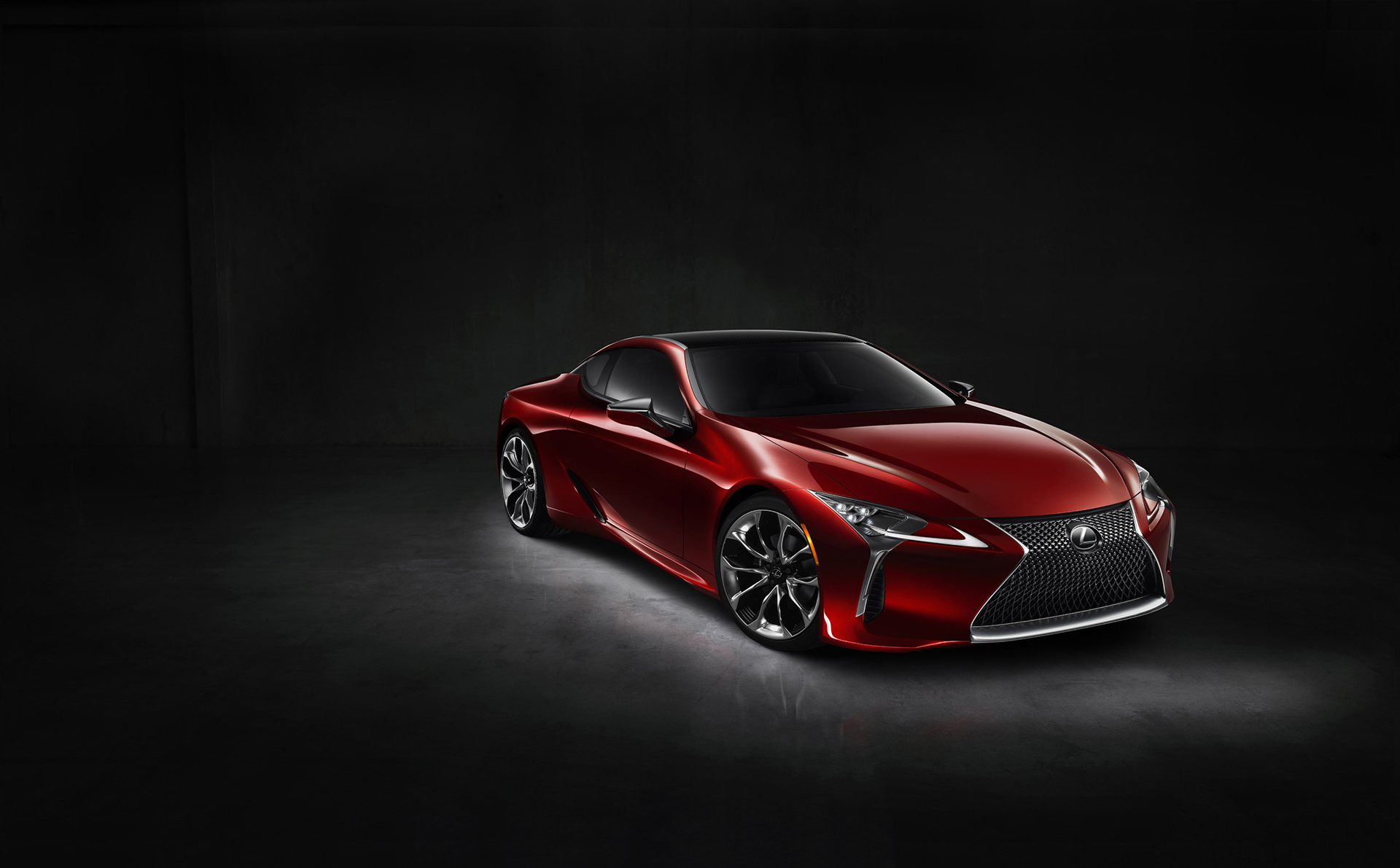
Lexus LC 500 – 2016 – front side-face / profil avant
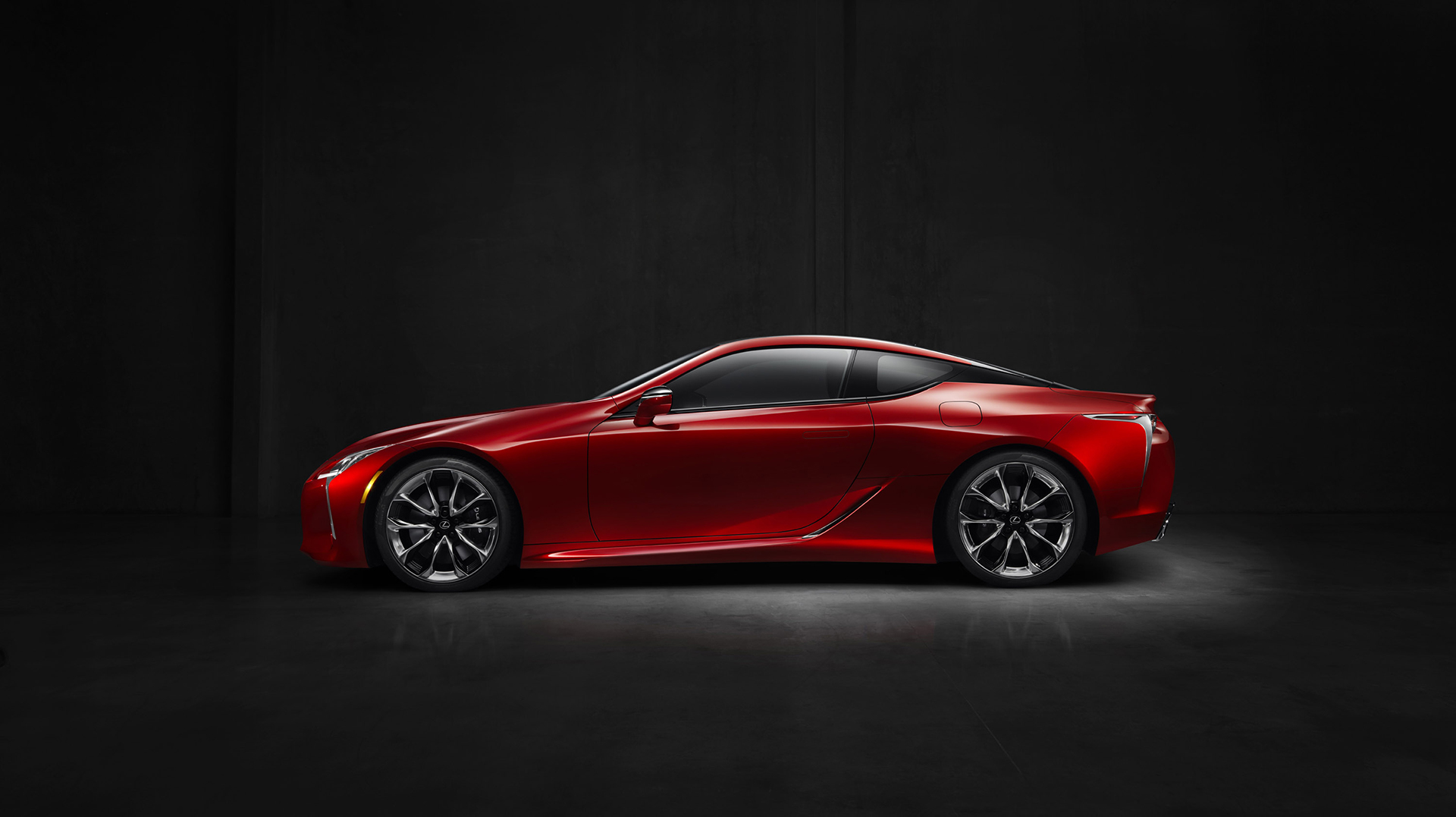
Lexus LC 500 – 2016 – side-face / profil
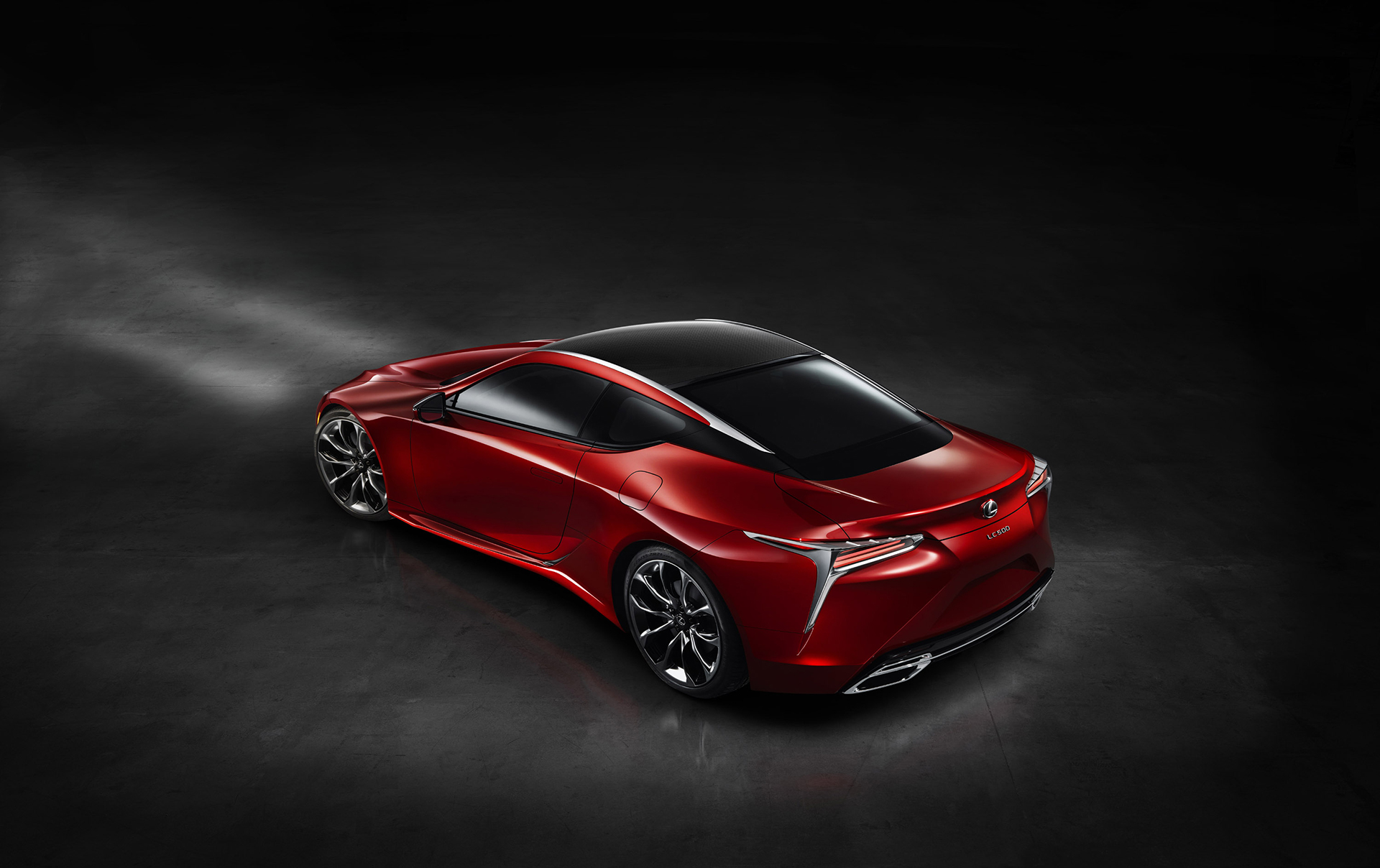
Lexus LC 500 – 2016 – rear side-face / profil arrière
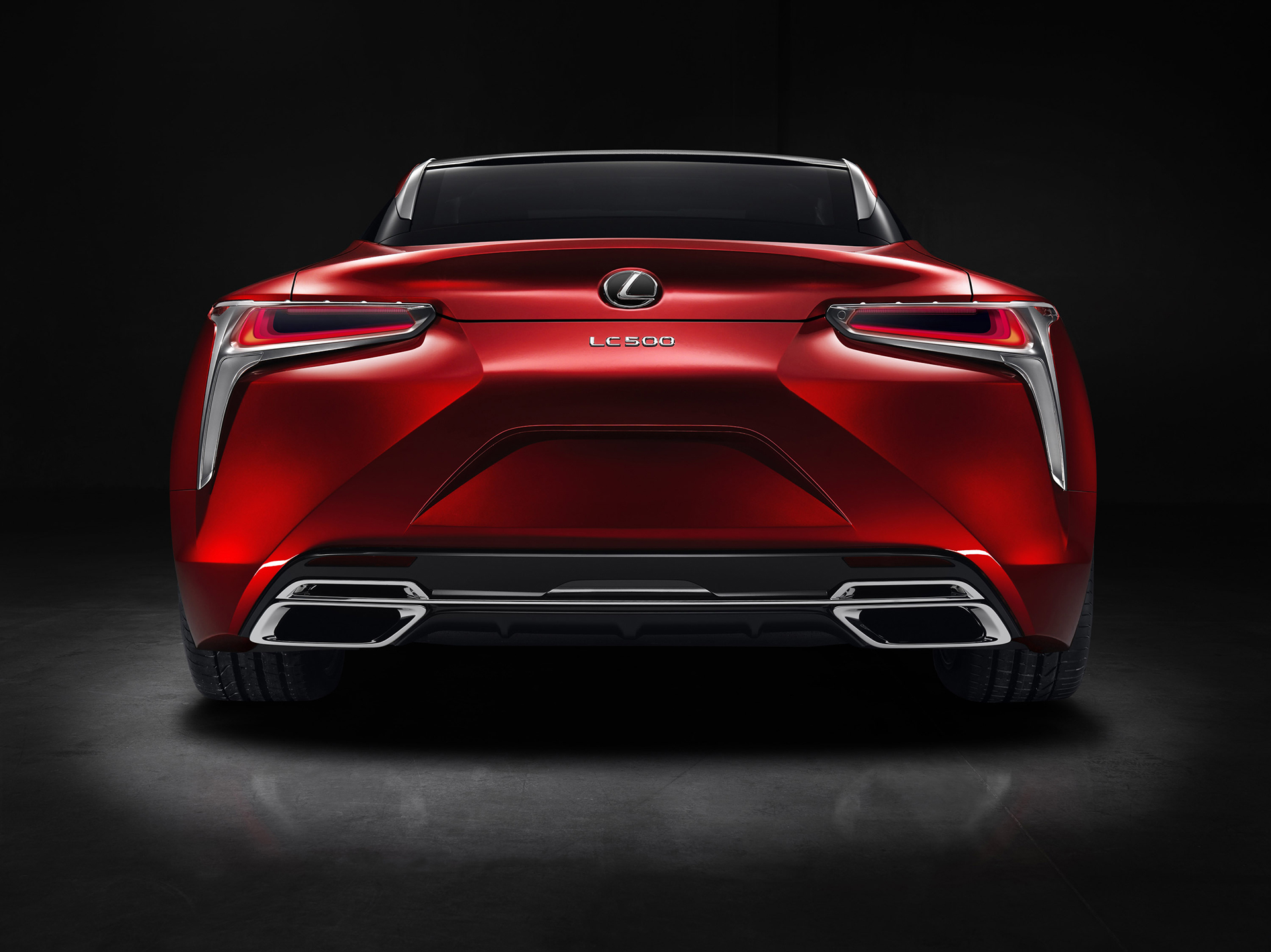
Lexus LC 500 – 2016 – rear / arrière
Le profil athlétique se caractérise par une ligne de pavillon très plongeante, une silhouette très effilée, un empattement long, des porte-à-faux avant et arrière réduits et un capot surbaissé. L’arrière se distingue par des feux combinés multicouche au dessin épuré créant un effet visuel unique.
Le design intérieur de la Lexus LC 500
Le design intérieur du LC 500 répond au thème d’un luxe dynamique affiché par le design extérieur avec une architecture élégante et centrée sur le poste de conduite. La position de conduite invite à une conduite vivante et sportive, elle met aussi en confiance grâce à un agencement très intuitif des commandes.
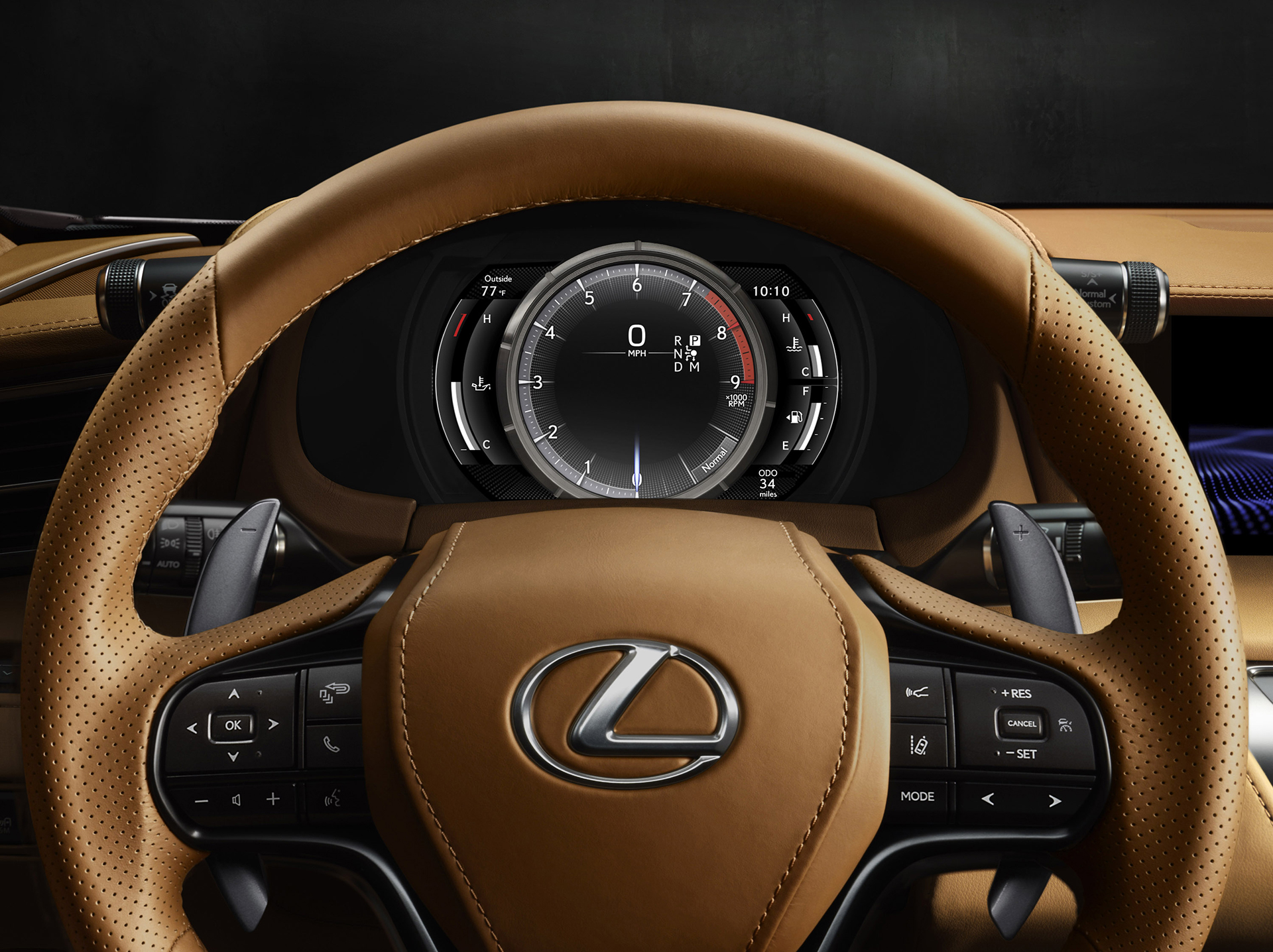
Lexus LC 500 – 2016 – racing wheel / volant
« Les designers ont collaboré dès le début du projet avec les ingénieurs pour comprendre leurs impératifs en termes de comportement dynamique et pouvoir les intégrer dans leur conception. Par exemple, nous avons étudié de près la ligne de vision du conducteur pour dessiner une surface correspondante qui soit adaptée à l’état d’esprit du pilote. Ce projet est l’un des premiers à impliquer aussi étroitement les designers dans le développement de l’ingénierie dynamique afin de mieux appréhender les enjeux de la conduite et y répondre par le design du véhicule. » - Tadao Mori, chief designer
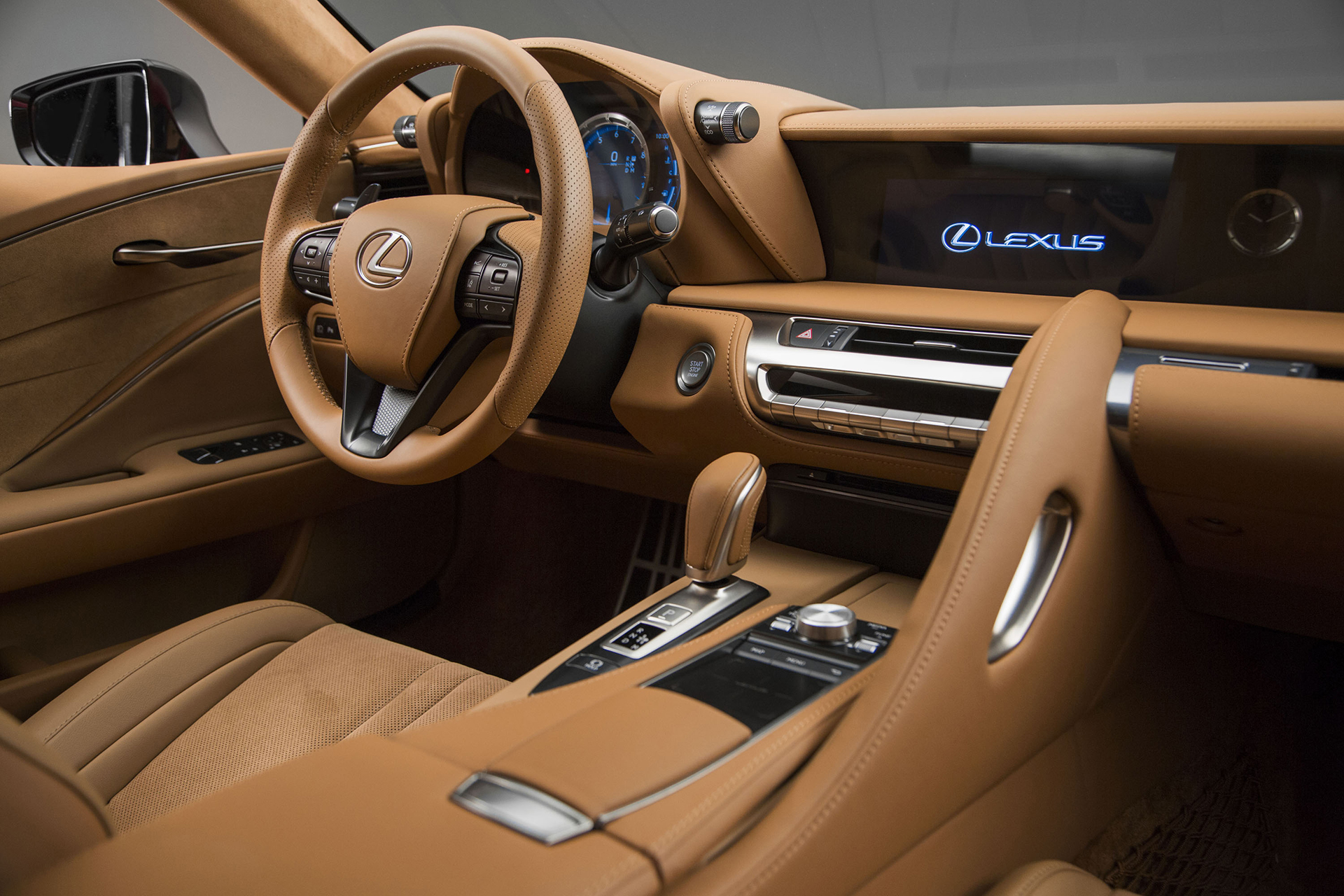
Lexus LC 500 – 2016 – intérior / intérieur
Les passagers bénéficieront également d’une expérience audio assurée par le système Mark Levinson, ou par le nouveau système de Pioneer.
Le châssis de la Lexus LC 500
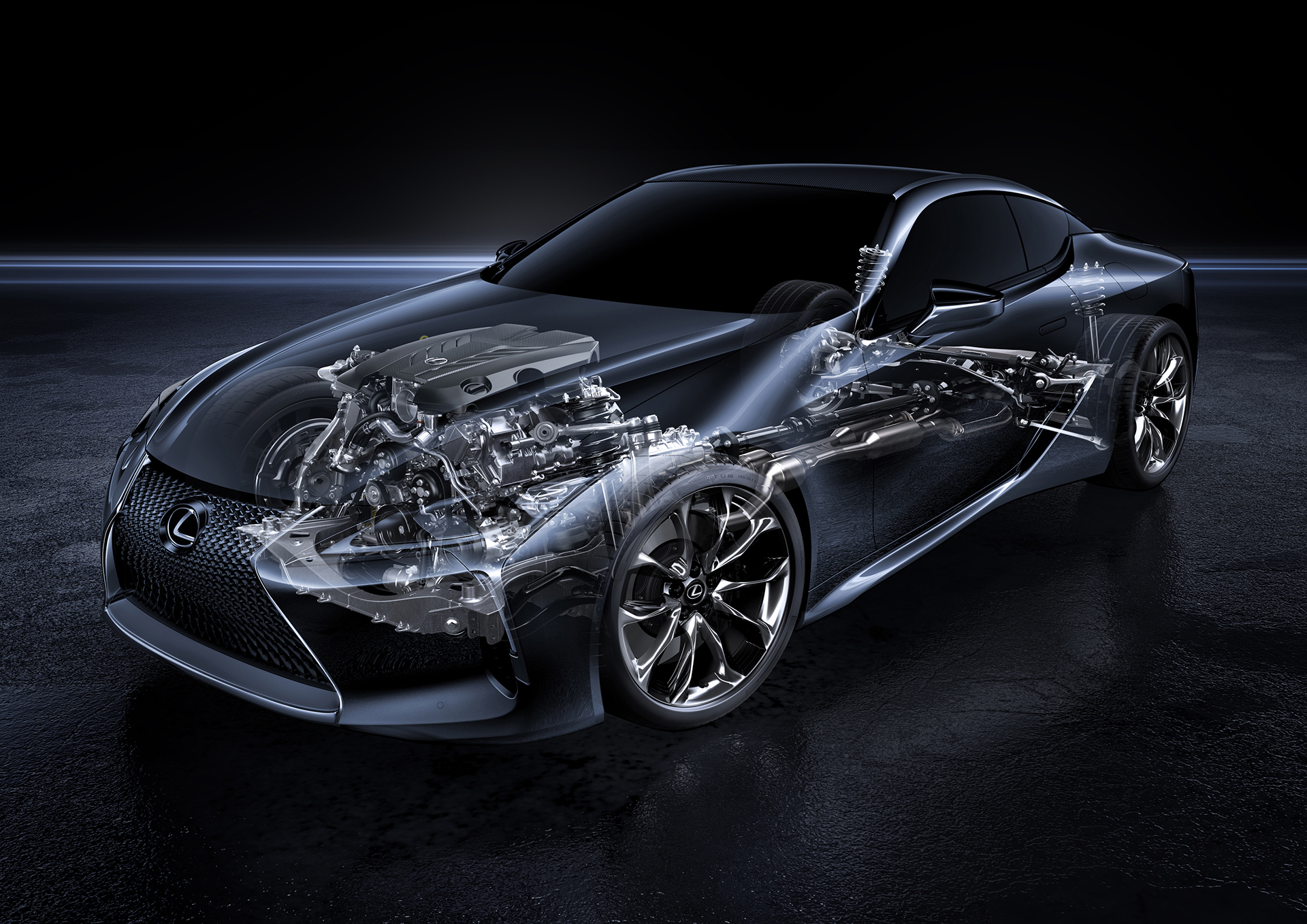
Lexus LC 500 – 2016 – drivetrain
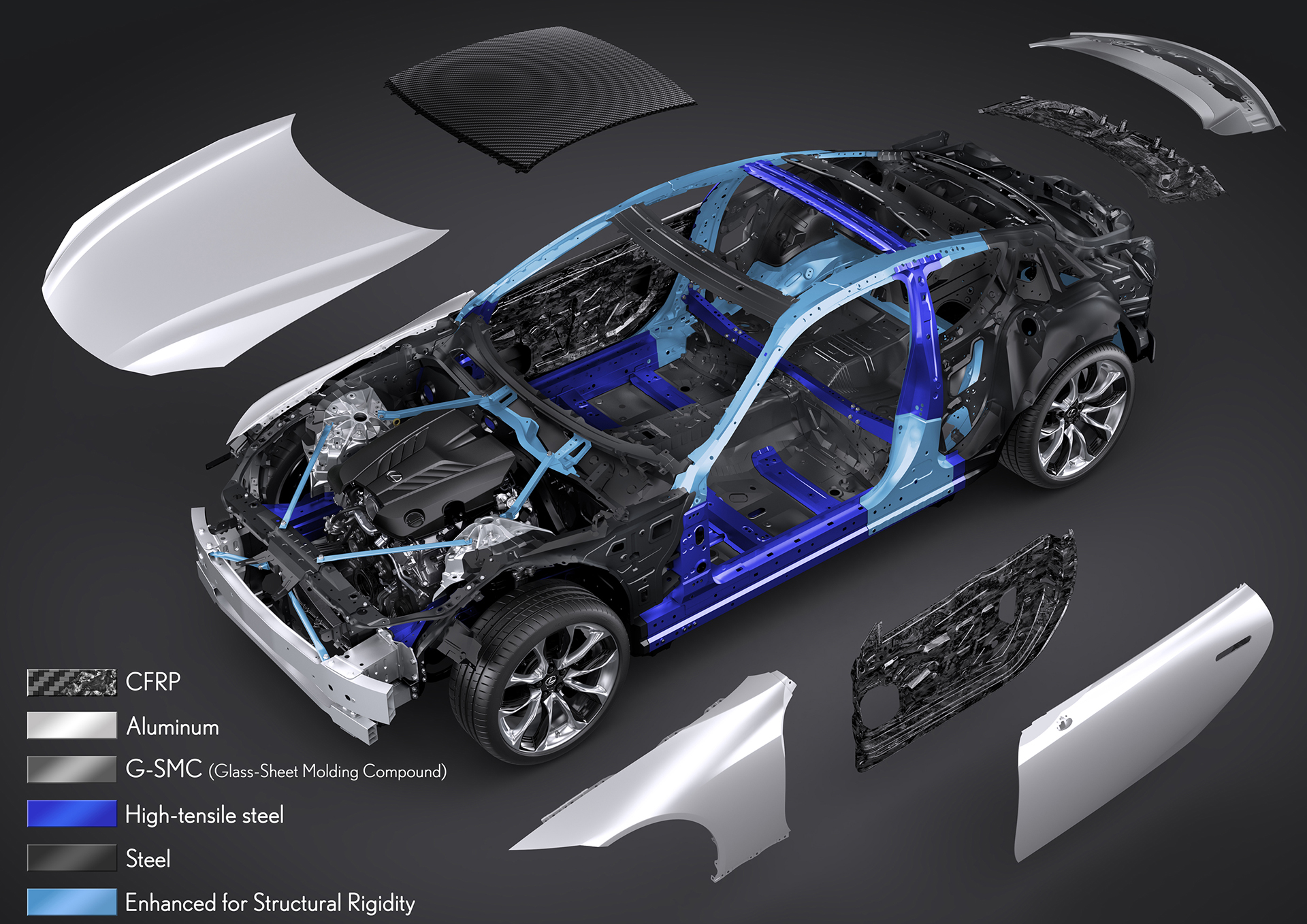
Lexus LC 500 – 2016 – chassis / châssis
Dans le souci de guider l’avenir de la marque Lexus, la mission du LC 500 est d’offrir une expérience de conduite dynamique inédite à ce jour sur un véhicule Lexus. La quête d’une expérience de conduite plus vivante et plus raffinée a constitué l’objectif premier de l’équipe de développement qui se devait également de préserver le confort de roulage exemplaire de Lexus et digne d’un luxueux coupé sportif emblématique de la marque.
GA-L
Le LC 500 est le premier modèle Lexus basé sur la nouvelle plate-forme premium à roues arrière motrices de la marque. Elle n’est partagée avec aucune Lexus actuelle et fait partie de la nouvelle architecture de Lexus pour ses véhicules de luxe destinés au marché international (Global Architecture for luxury vehicles – GA-L). La plate-forme de ce nouveau coupé préfigure les futurs véhicules à moteur avant et roues arrière motrices du constructeur.
Pour atteindre le niveau de performances du châssis défini pour son nouveau coupé, les ingénieurs de Lexus ont conçu la carrosserie monocoque la plus rigide de toute son histoire.
« Nous avons passé trois fois plus de temps que la normale pour la recherche et le développement afin d’obtenir une direction absolument linéaire et identifier les points critiques pour un ressenti idéal. Nous avons également travaillé sur la rigidité de la suspension et peaufiné la géométrie. Grâce au progrès de l’ingénierie, la rigidité de la suspension et la tenue à l’accélération latérale sont désormais au meilleur niveau mondial. » - Koji Sato
Pour assurer sa motricité et sa tenue de route, la LC Lexus 500 chausse des Michelin Pilot Sport.
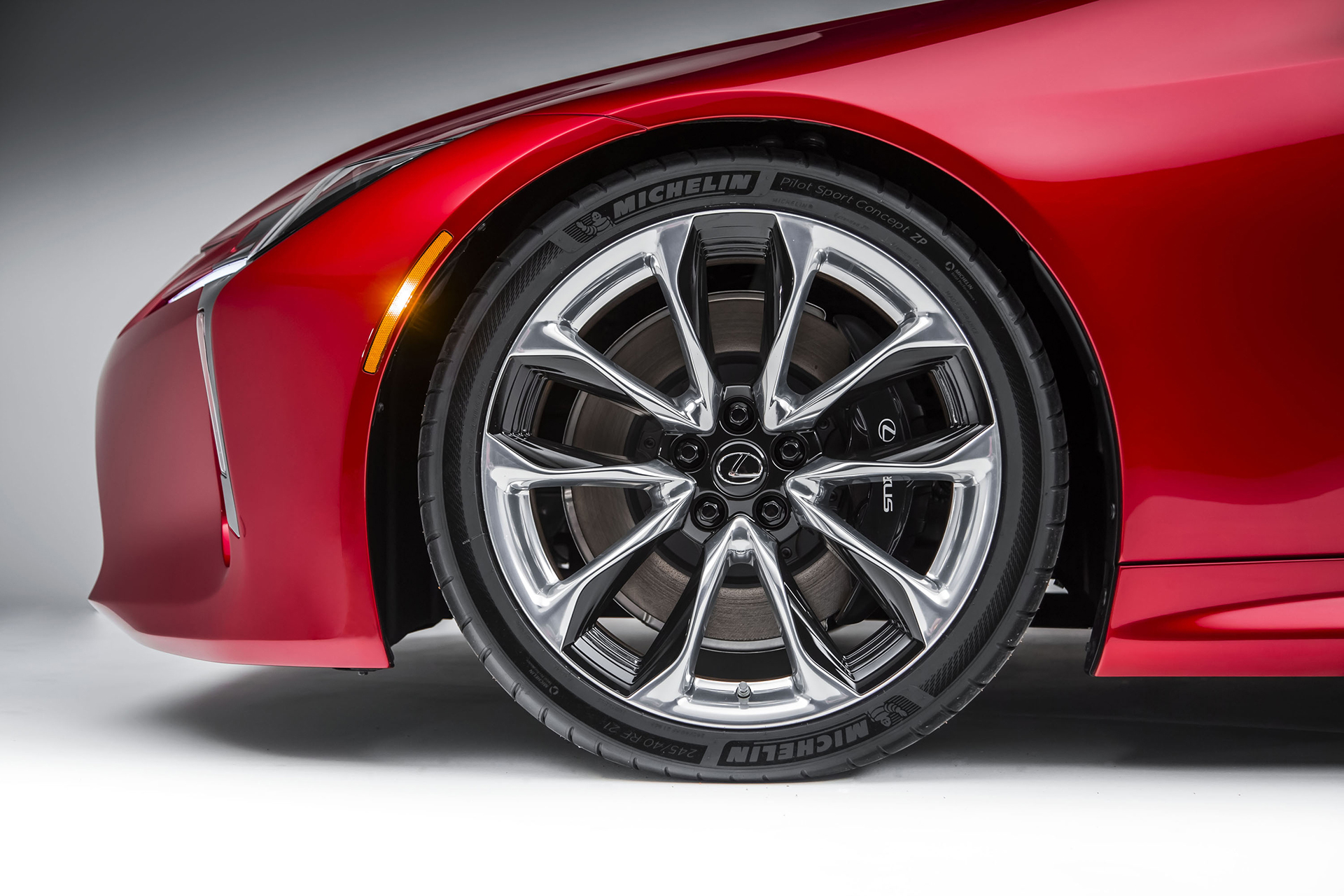
Lexus LC 500 – 2016 – wheel / jante
Le moteur de la Lexus LC 500
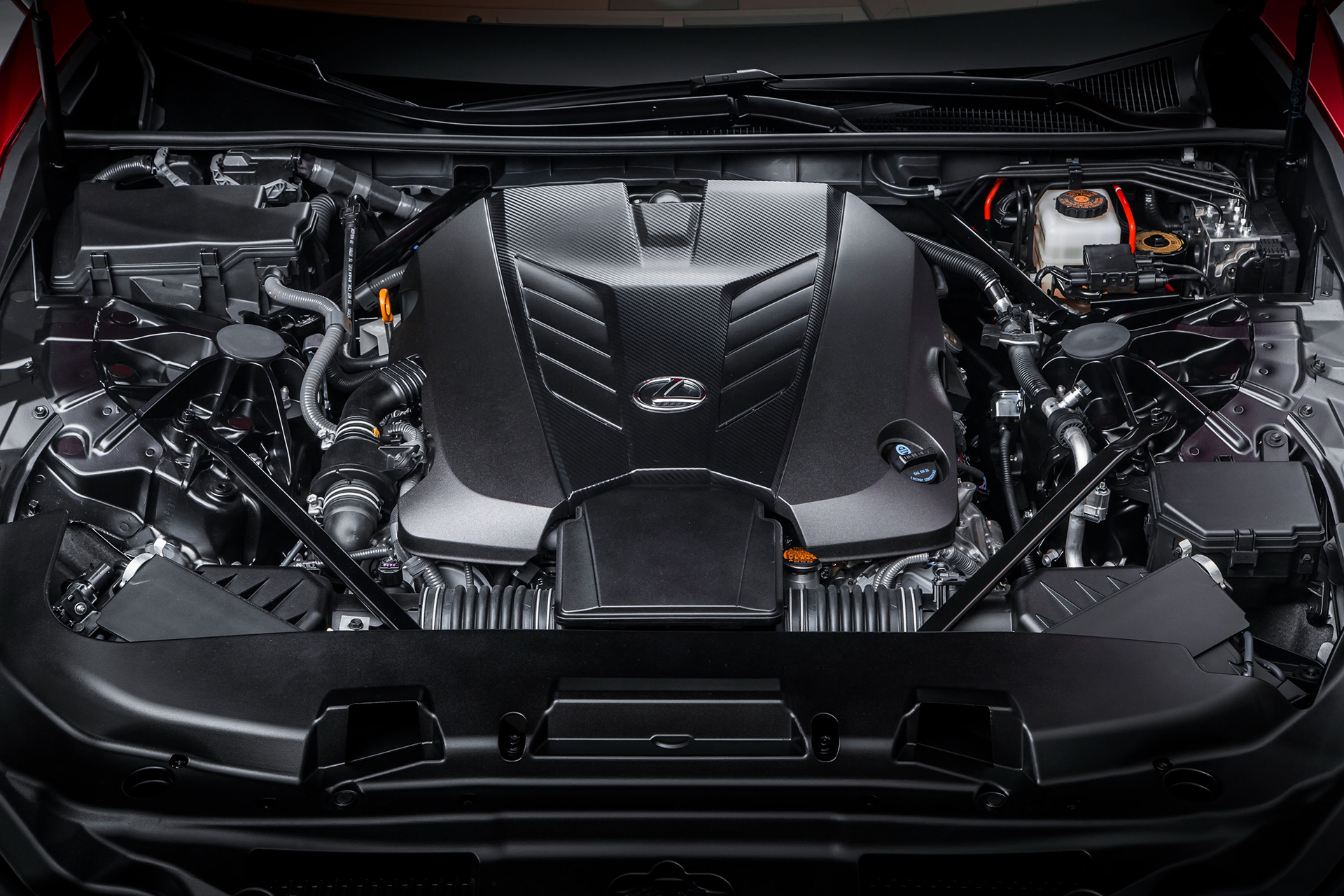
Lexus LC 500 – 2016 – under the hood / sous le capot
La puissance du LC 500 est délivrée par le puissant moteur 5,0 litres des RC F et GS F. Ce V8 atmosphérique a été choisi pour son onctuosité, la progressivité de sa réponse à l’accélération et sa sonorité exaltante. Tout en aluminium, doté de 32 soupapes, il développe 473 ch et un couple de 527 Nm.
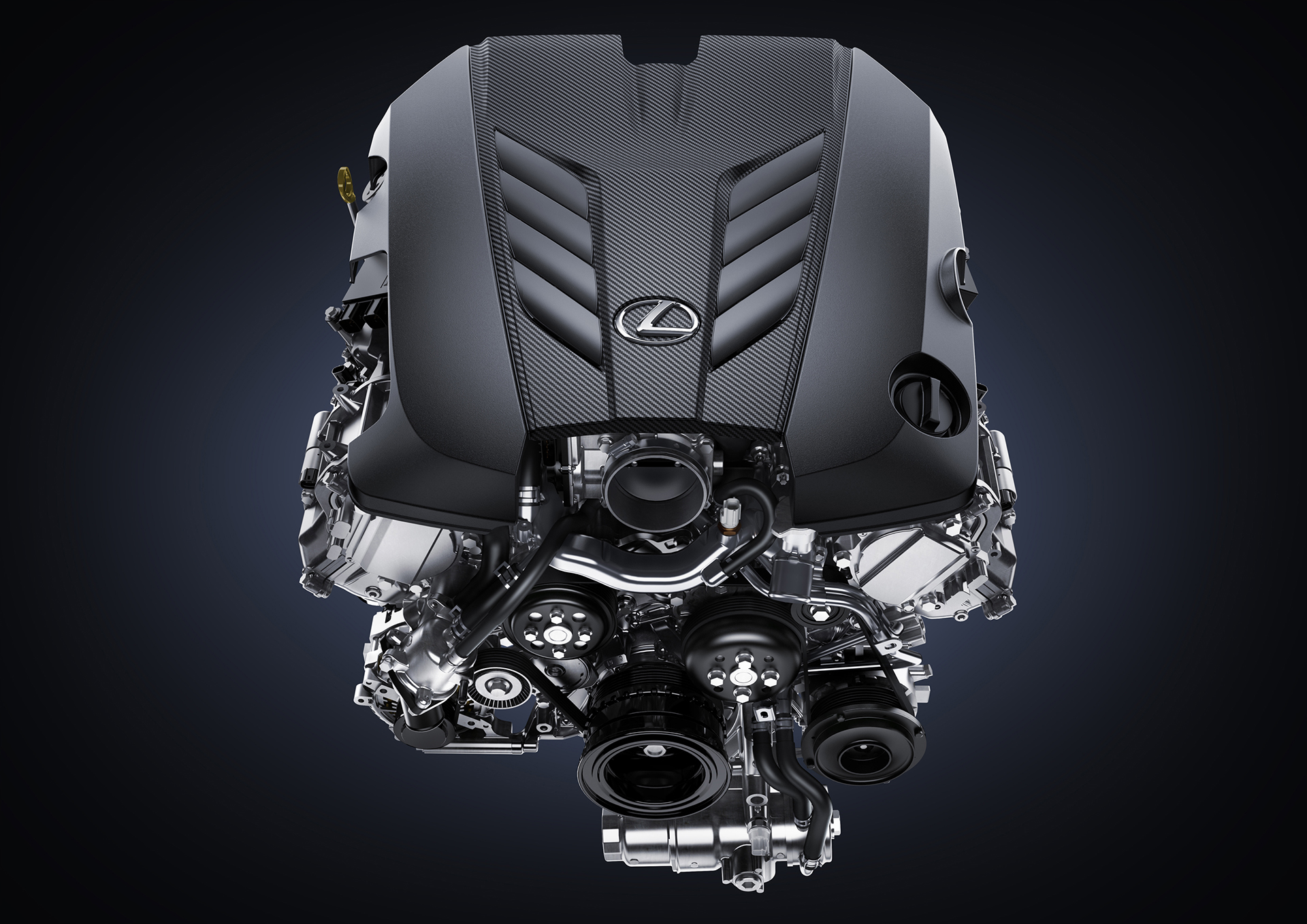
Lexus LC 500 – 2016 – engine / moteur
La transmission de la puissance aux roues arrière est assuré par une nouvelle boîte automatique à 10 rapports – une première sur un véhicule de luxe – dont la vitesse de passage rivalise avec celle d’une boîte à double embrayage.
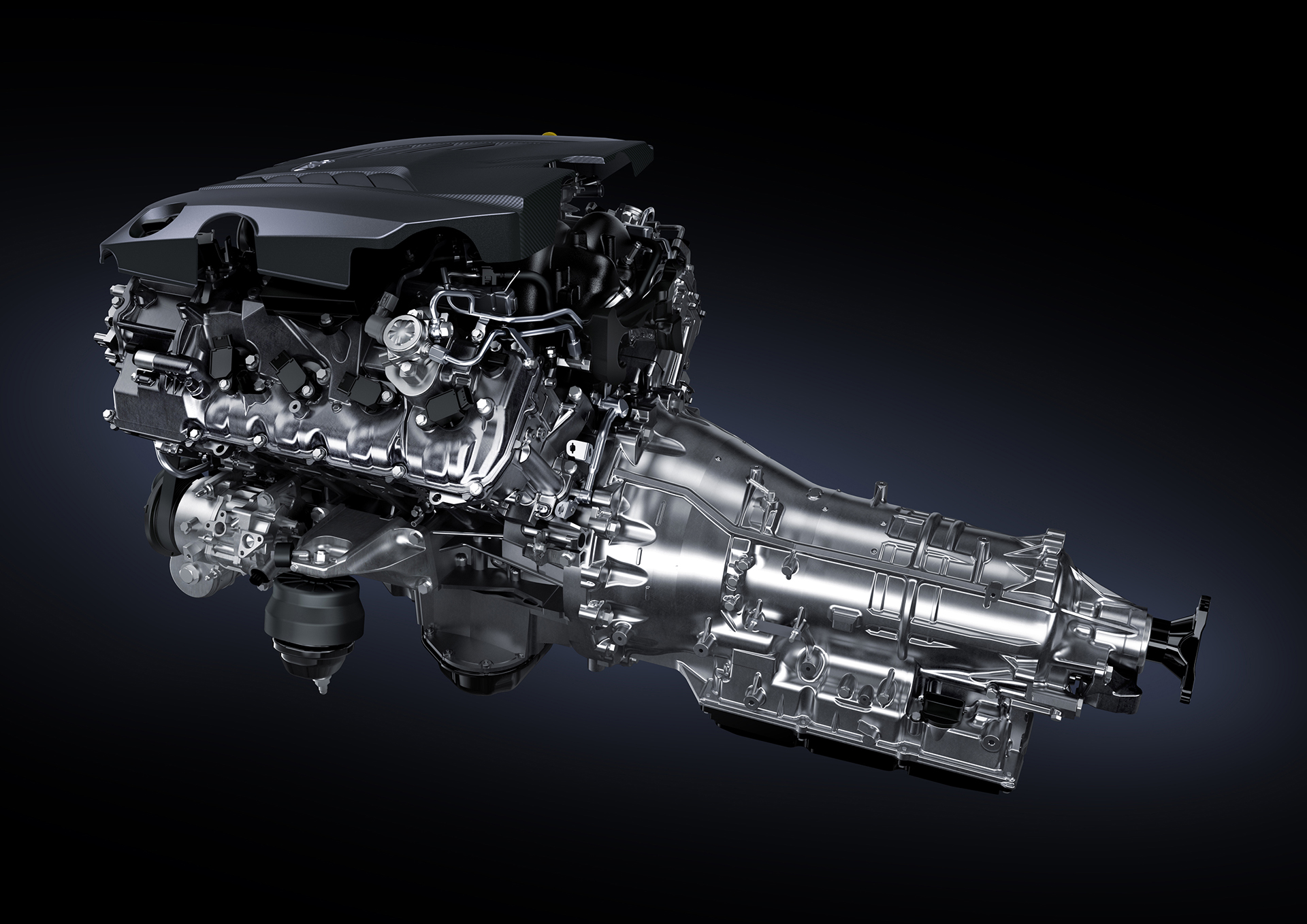
Lexus LC 500 – 2016 – engine gearbox
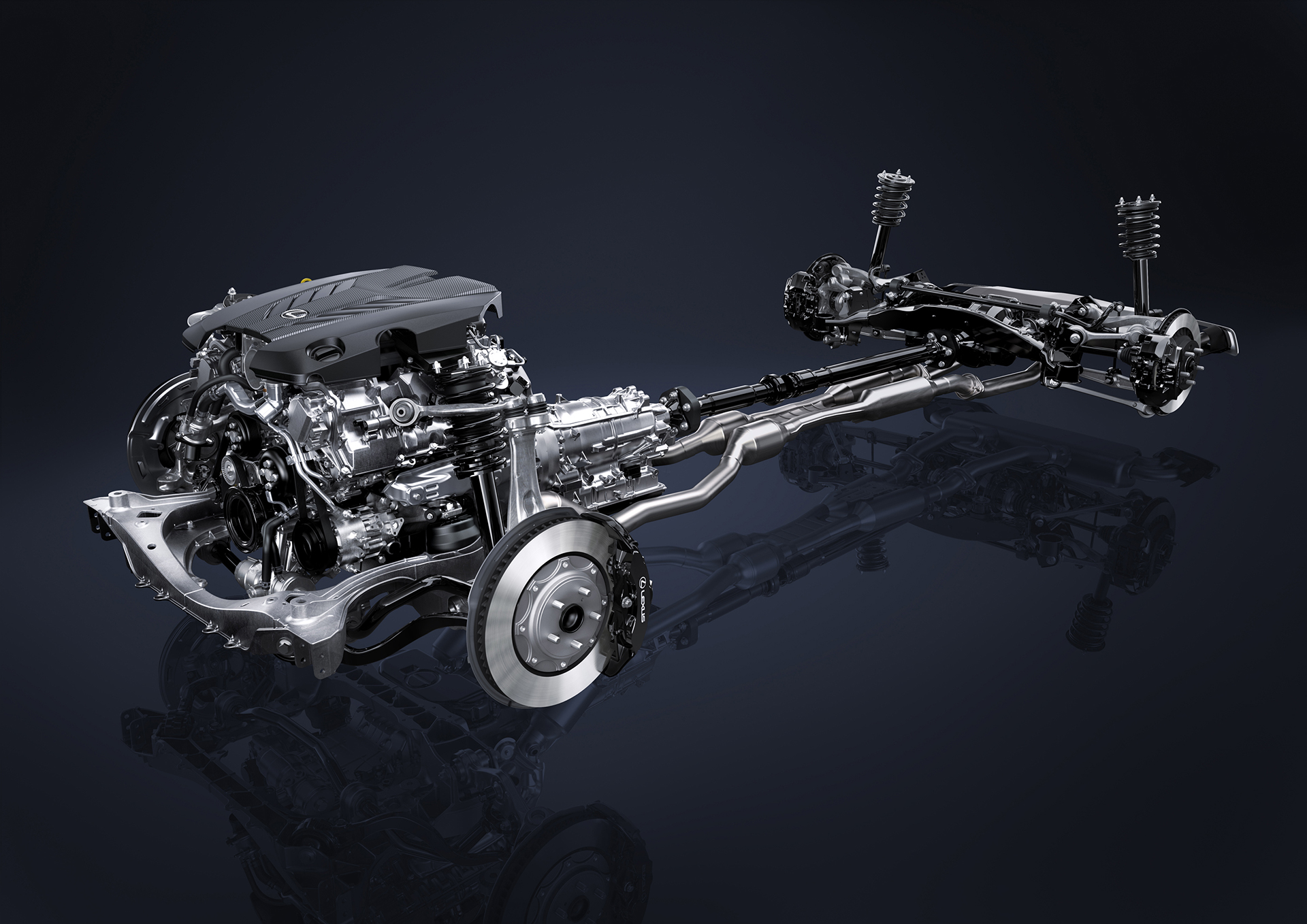
Lexus LC 500 – 2016 – powertain
Grâce à la conception de sa plate-forme et de sa chaîne cinématique, le LC 500 affiche des performances et une agilité peu communes pour un grand coupé à quatre places. L’auto accélère ainsi de 0 à 100 km/h en 4,5 secondes.
English summary
Global Debut of All-New Lexus LC 500 at the 2016 NAIAS
Signals Dawn of a New Era for Lexus
When the Lexus LF-LC Concept debuted at the 2012 North American International Auto Show, the press, loyal customers, and enthusiasts wondered if the concept’s arresting styling and dramatic proportions could ever evolve into a production 2+2 coupe. Today, four years after the debut of the breakthrough concept that inspired it, Lexus has revealed the all-new LC 500 luxury coupe. This provocative, athletic flagship coupe makes the strongest statement yet about Lexus’ future product direction.
The past five years have seen Lexus evolve rapidly with the creation of the luxury brand’s globally-focused organization, Lexus International. Exciting new models involving elevated levels of emotional styling and dynamic driving characteristics such as NX, RC, and IS have also helped Lexus’ brand shift with consumers. Akio Toyoda has been at the center of the Lexus global expansion, personally driving a heightened level of collaboration among design, engineering and marketing teams to help build a luxury brand better suited to meet the needs of the next generation of consumers.
“The LC 500 has been an important product for Lexus and me personally. A few years ago, we decided to guide the future of the brand with products that had more passion and distinction in the luxury market. This flagship luxury coupe’s proportions, stunning design and performance make a strong statement about our brand’s emotional direction and will grow the Lexus luxury appeal globally.”
- Akio Toyoda, Chief Branding Officer and Master Driver for Lexus
Design and Engineering Teams United
Beyond its styling and impactful performance, the new LC 500 serves as a symbol of the achievement that can result from heightened collaboration between design and engineering groups and their commitment to help overcome each other’s hurdles. When Akio Toyoda challenged these development groups to produce this special car, it meant surpassing many manufacturing, design, material, and dynamic obstacles that could typically compromise a vehicle’s targets or design vision.
The LC 500 was driven by a strong, appealing fundamental design target (LF-LC), and engineering teams worked tirelessly to find new solutions to maintain as much of the concept in the production car as possible. Likewise, vehicle designers were very involved from the earliest stages of the dynamic development process to understand the engineering targets and collaborate with design viewpoints and potential solutions. With LC 500, additional levels of prototype vehicle build also allowed both teams to better study design or engineering ideas and refine key elements. For Lexus, the LC 500 project became much more than simply the development of a new coupe. The LC 500, with the shift in engineering processes and design ideologies it represents, symbolizes the beginning of a new phase for the Lexus brand.
“Design and engineering sides worked together on issues and obstacles that were overcome one by one. I feel we achieved something greater than simply preserving the spirit of the concept’s design.” - Chief Engineer Koji Sato
Exterior Design
At first glance, it becomes apparent that the engineering and design team’s collaboration was highly successful, considering how much of the LF-LC’s design ideology the team was able to transfer into the new LC 500. The new production model shares many of the key design elements, proportions and visual dynamism of the concept car that inspired it. The LC 500’s visual appeal is defined by an athletic aerodynamic shape. It features sensual curves, emotional forms, an available flowing carbon-fiber roof (glass roof standard), helping create a low, wide imposing stance that comes together for a highly functional, passionate package.
The LC 500’s front fascia features a powerful interpretation of Lexus’ distinctive grille, bordered by chrome on three sides and a radical new 3D mesh design that varies its visual tension.
The “L”-shaped daytime running lights rest below a new Triple LED headlamp unit, specially designed to include one of the industry’s thinnest projectors enabling a low hood with a short front overhang. Functional venting also plays into the LC 500’s exterior design to help improve aerodynamic stability and cooling.
The car’s athletic profile is characterized by its fast, sloped roofline, its wind-cutting silhouette, a long 2,870 mm (113 inches) wheelbase with compact front 920 mm ( 36.2 inches) and rear 970 mm ( 38.2 inches) overhangs and low hood height. The sexy curves and flowing lines maintain a consistent tension in sheetmetal through to the rear end that features slimly designed, multi-layered tail lamps with a unique lighting effect that helps convey a sequential L motif.
A rear diffuser and available active rear spoiler also help manage airflow during performance driving. It rides on machined cast aluminum 20-in. or available 21-in. forged aluminum wheels.
Lexus LC 500: On the Road in 360
Everyone wants to experience the LC 500, Lexus’ visionary concept car turned powerful
reality. Now you can. Join Lexus on the road with the LC 500. With our 360 video, you can take it all in for yourself.
Interior Design
The interior design of the LC 500 is influenced by the dynamic luxury theme of the exterior with a layout that is both cockpit-focused and elegant. The coupe’s driving position was calibrated to invite spirited, sporting driving, and help develop easier confidence with a more intuitive control layout. In fact, for LC 500, the driver’s hip point was engineered to be as close as possible to the vehicle’s Cg (Center of gravity) where feedback from the car is the most communicative to the driver.
The front seats offer excellent support and comfort for long drives while available sport seats offer additional bolstering and lateral support during cornering. Lexus engineers put considerable effort into creating an engaging yet seductive atmosphere for the driver, focusing on details such as the size and angle of the steering wheel, the feel and positioning of magnesium alloy paddle shifters, and available supple leather and Alcantara seating surfaces. The LC 500’s exquisite door panels, center console and dash pad structures feature elements of Lexus’ world-renowned, detail-obsessed Takumi craftsmanship in their finish.
“At an early stage, the designers collaborated with the engineers to understand their image for the LC 500’s driving dynamics, and they incorporated this into the design. For example, we gave serious consideration to where the driver’s eyes would focus, and designed the surface shape in that area to help support a driver’s mindset. This project was one of the first times that designers were closely involved in the dynamic engineering development so we could understand the driving goals and support with the car’s design.” - Tadao Mori, the chief designer of the LC 500
Interior Electronics
This flagship coupe will debut the 2017 Lexus Multimedia package that will feature updated, faster, more flexible software enabling future enhancements and a more inviting graphic user interface. Occupants also will be treated to an exceptional audio experience inside the cabin: in addition to the available audiophile-worthy Mark Levinson audio package, a new premium Pioneer audio system comes as standard equipment. Pioneer’s sound engineers worked in collaboration with LC 500 body and cabin designers to enhance interior sound performance within the cabin, studying the acoustic environment and driving structural changes to enhance sound performance.
Lexus LC 500: A 360 Look Inside
Join Lexus behind‐the-scenes at a photo shoot featuring the all-new LC 500, a visionary concept car turned powerful reality. With 360 video, don’t just watch—take a look around the interior for yourself.
Chassis
In helping to drive the future of the Lexus brand, the mission for LC 500 is to offer a dynamic driving experience and character unlike any Lexus vehicle prior to it. The pursuit of a sharper, more refined driving experience became the mission for the development team who also sought to maintain a superior Lexus ride quality befitting a flagship luxury sport coupe.
GA-L
The LC 500 is the first Lexus to use the brand’s all-new, premium rear-wheel-drive luxury platform and is part of the new corporate global architecture for luxury vehicles (GA-L). The underpinnings of this new coupe will become the blueprint for the company’s future front-engine/rear-wheel-drive vehicles. In an effort to sharpen the car’s handling, the LC 500’s engineers focused on the platform’s fundamentals by placing most of the mass, including the engine and the occupants, in a position more centralized and lower in the chassis to improve the center of gravity.
Internally, Lexus engineers referred to this menu of mass-arranging tactics as the “inertia spec.” The driver hip and heel points have been lowered, wheels have been pushed to the corners of the car with shortened overhangs, and the drivetrain mass has been located behind the front axle line to create a front mid-ship layout. The LC 500 also relies on run-flat tires to improve packaging, reduce weight (thanks to no spare), and help shorten overhangs to achieve dynamic targets. The 12-volt battery has been relocated to the trunk as part of the mission to redistribute weight.
Other mass management measures include the available carbon fiber roof, aluminum door skins mounted to the carbon fiber door inner structure, and a composite trunk floor. The LC 500 also represents the Lexus brand’s most intensive use of high-strength steel. This provides enhanced rigidity while reducing—and ideally positioning—vehicle mass to optimize dynamics. As a result, the LC 500 is very balanced with a nearly ideal front/rear weight distribution of 52/48.
To help achieve the level of chassis performance targeted for this new coupe, Lexus engineered the stiffest unibody the brand has ever produced. For LC 500, the strategic use of lightweight, high-strength steel helps make for a high degree of torsional rigidity that is more resistant to twisting forces than the exotic, carbon fiber-intensive LFA supercar.
The platform design maintains a consistent level of resistance to flexural forces and stiffness across the vehicle’s wheelbase to help create consistent, predictable handling behavior and sharper steering responses. Special braces in the engine compartment (usually a more twist-prone part of the chassis), the adoption of stiff aluminum front suspension towers, and the addition of a ring structure near the rear fenders are all measures that help further bolster the strength of key chassis structures.
Particular attention was devoted to the LC 500’s multilink suspension system. Double ball joints on the upper and lower control arms allow for control of the smallest movements from the driver inputs and road conditions. Beyond sharing workload, a dual ball joint arrangement helps optimize suspension geometry to increase wheel control and create a more precise steering response with better initial effort. To help reduce unsprung mass and improve suspension response, all but one of the control arms are made of lightweight forged aluminum.
“Michelin’s global development team worked very closely with the Lexus team to develop a Pilot Super Sport that helps meet the high performance and safety needs of the Lexus LC 500. Owners will enjoy the peace of mind that Michelin run-flat technology offers without giving up the quiet cabin and comfortable ride that Lexus owners value.” - Thom Roach, vice president of original equipment marketing, Michelin North America
Providing the grip on the show prototype car are concept versions of Michelin Pilot Sport tires with Premium Touch sidewall technology: 245/40RF21 up front and 275/35RF21 at the rear. When all the handling elements come together, LC 500 becomes a world-class luxury sports coupe that exhibits razor-sharp reflexes, exceptional handling balance and rock-solid stability. This all-new platform will continue to undergo continuous improvement and enhancement throughout the vehicle’s lifecycle.
“We spent more than triple the usual amount of R&D time to pursue linear steering and to find the sweet spot for road contact feel. We also focused our efforts on suspension rigidity and enhancing geometry. Thanks to advancements in product engineering, we are now at a world-class level for suspension rigidity, and performance when lateral g’s are applied.” - Sato
Drivetrain
The power delivery to the rear wheels for LC 500 is handled by a new, very well matched set of components that maximize output to the wheels. The heart of the new LC 500 is derived from the proven, high-revving 5.0-liter V8 that is found in the RC F and GS F. The naturally aspirated V8 was selected for its smooth, linear throttle response and emotional engine sound. The all-aluminum, 32-valve V8’s output targets 467 HP and 389 lb.-ft. of torque.
The new engine is built for durability with lightweight, high-strength forged connecting rods and titanium valves that allow the engine to flourish at high rpm. This naturally aspirated engine makes an ideal pairing to a balanced sports coupe with its linear power delivery that allows easier control and exhilaration behind the wheel.
The engine in the LC 500 uses a dual intake inlet that help improve breathing and allow the engine to produce its fantastic sound. The new coupe features an active exhaust that opens baffles in Sport mode to help give the car a more aggressive exhaust note even in start-up. In fact, even when the vehicle is in Normal mode the exhaust baffles open above 3500 rpm. During acceleration, a Sound Generator involving tuned acoustic plumbing enhances the engine’s raucous melody into an aural thunder that helps distinguish the LC 500 in its competitive segment.
Helping power transfer to the rear wheels is a newly developed 10-speed automatic transmission—the first ever in a luxury automobile—with shift times rivaling those of a dual-clutch transmission. The component is smaller and lighter than some current 8-speed transmissions. The wide bandwidth of shifting afforded by 10 closely spaced gears is ideal for all forms of driving, providing an optimal gear in all conditions. This transmission is matched to a new electric control system with software that helps anticipate the driver’s inputs by monitoring acceleration, braking and lateral g forces.
The new transmission is just one key element in a vehicle that has had all of its dynamic control elements such as power application, braking, and steering tuned to operate rhythmically in sport driving conditions. Drivers will feel the controlled balance between the quick, smooth shifting actions, the application of linear engine power, and the deceleration afforded by 6-piston front brake calipers (4-piston at rear).
All of the platform and drivetrain engineering helped endow the LC 500 with performance and agility uncommon for a four-person coupe; the vehicle targets a 0 to 60 mph time of less than 4.5 seconds.
Source et images :
Lexus
Partager la publication "Lexus LC 500 : レクサス Luxury Coupe, V8 5.0L 473 ch. exporté à Detroit présenté au NAIAS 2016"

